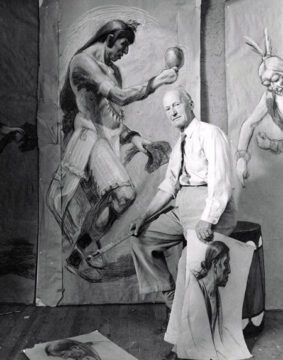
The Rosenberg Library celebrated the holiday season with a display of woodcut and lithograph greeting cards created by renowned Taos artist Joseph Imhof for the December Treasure of the Month. These wonderful works of art were custom-made each year by Imhof and sent to family and friends. Galveston locals William and Viola Pabst were avid collectors of all things Native American, especially from the Southwest, and likely befriended the artist during one of their many trips to New Mexico. They donated the greeting cards, along with an extensive collection of Native American artifacts, to the Rosenberg Library in 1986.
Joseph Imhof’s story began far away from the rolling vistas of Taos, New Mexico in Brooklyn, New York where he was born in 1871. Interested in art from an early age Imhof defied his father’s wish that he become a priest, and instead taught himself lithography. After graduating high school he was hired by Currier and Ives – the most prolific and successful company of lithographers in the nation. Imhof saved his money until he was able to purchase a bookstore. In 1881 he quit his job, sold the store and traveled to Europe for four years where he trained with several artists. In Europe he met ‘Buffalo’ Bill Cody and sketched many of his “Wild West Show” members as they traveled the continent. These years were important not only because they helped Imhof hone his artistic and technical abilities, but because Imhof found his true artistic passion – depicting Native Americans in a realistic and dignified manner.
Upon his return to the United States, Imhof rented a studio in Flatbrush where he studied Iroquois Indians and continued his career in lithography, photography, and color printing. In 1897 he married Sarah Ann Elizabeth Russell. The two traveled extensively throughout Europe together until in 1905 they visited the Southwest for the first time. The couple fell in love with the land and the people who lived there, and in 1906 Joseph built a studio in Albuquerque.

By 1929 the couple moved to Taos permanently, and built their home near the city’s sacred mountains. Joseph Imhof developed some peculiar habits as an artist that helped earn him the moniker “the grand old man of the Pueblos.” He often asked his, mostly Native American, subjects to live with him before he painted them so that he could better capture their likeness. This period also saw Imhof start the first lithography press in Taos and establish the area as a hotbed of artistic expression for years to come. He passed away in 1955 in his adopted city. Years later his wife Sarah remembered him as a “…gentle, dignified man who loathed the publicity and the limelight that other artists seemed to seek.”
On display were four notable greeting cards made by Imhof and sent to his friends and family during the holiday season. The first is a lithograph with a Pueblo woman standing in front of a mission holding a pipe. Her shawl covers everything but her head, forcing the attention of the viewer to the stoic features of her face. This noble presentation is typical of Imhof and is what made him stand out from many of his contemporaries. The 1946 Christmas Deer Dancers is much more abstract and playful. Its subject seems alien at first, but novelty leads to curiosity of this strange spiritual realm. The woodcut Ceremonial Rabbit Hunt is more subdued, and is meant to be documentary in nature. It shows two club wielding hunters atop galloping horses and a dog as they pursue a small rabbit. The final lithograph is a 1939 landscape. It shows a statue inside a fountain with the Taos mountain range in the background. Imhof friend and biographer Nancy Reily states that the sculpture was made by the artist and was kept on the patio of his Taos home. Her family had a similar one that they called the Rain God.
William and Viola Pabst were lifelong collectors of Native American artifacts. Mr. Pabst was BOI and belonged to a prominent family. His father Fred Pabst (1864 – 1952) was selected by President Wilson to be the customs collector for Galveston, a position he held for many years. He also owned a real-estate company, served as county commissioner, and even had a fruit orchard in Dickinson. William continued the family business and served as a partner in the Pabst Reality Company. To learn more about Joseph Imhof please see Nancy Hopkins Reily’s biography Joseph Imhof, Artist of the Pueblos which is available for check-out at the Rosenberg Library.